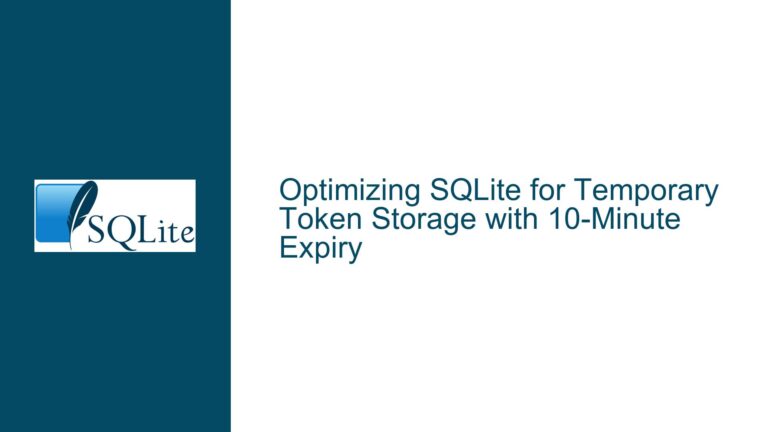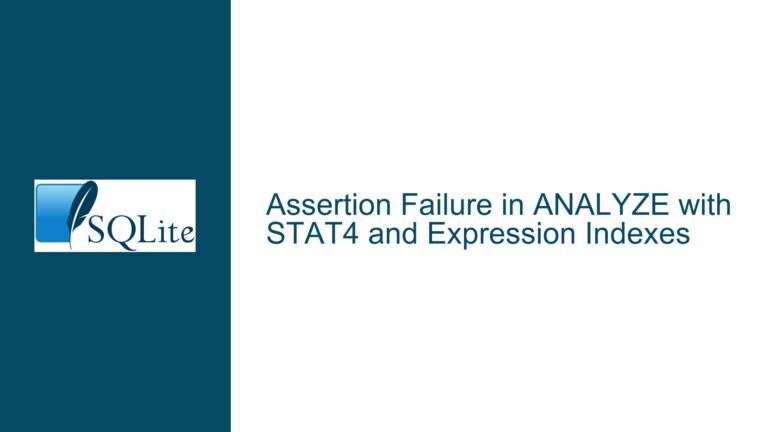Concurrent Read Queries on SQLite In-Memory Databases: Performance Serialization Causes and Solutions
Issue Overview: Concurrent Read Query Serialization in SQLite In-Memory Databases
SQLite in-memory databases configured with shared cache connections via URIs like file:memdb1?mode=memory&cache=shared may exhibit unexpected serialization of concurrent read queries across multiple threads or connections. This manifests as reduced performance compared to equivalent disk-based databases where concurrent reads execute in parallel. The core issue revolves around how SQLite’s Virtual File System (VFS) layer and locking mechanisms interact with in-memory storage.
In disk-based configurations, SQLite leverages file-system locks and Write-Ahead Logging (WAL) to enable concurrent read operations. However, in-memory databases bypass the file system entirely, relying on memory buffers and custom synchronization primitives. The default in-memory VFS (memdb) uses a single global mutex to serialize access to the database, even for read-only operations. This contrasts with disk-based setups, where read transactions can proceed concurrently under WAL mode.
Key observations include:
- Thread-Specific Connections: Each thread opens a separate database connection to the shared in-memory database.
- No Write Operations: The workload consists purely of read queries (SELECT statements).
- Performance Metrics: CPU utilization remains low, with query execution times scaling linearly as the number of threads increases, indicating a lack of parallelism.
This behavior is counterintuitive because read operations typically do not require exclusive locks in SQLite. The discrepancy arises from implementation details in SQLite’s in-memory VFS and shared cache configuration.
Possible Causes: VFS Locking Mechanisms and Shared Cache Configuration
The serialization of read queries in SQLite in-memory databases stems from three interrelated factors:
Default In-Memory VFS Locking Strategy:
SQLite’s built-in in-memory VFS (memdb) uses a single global mutex to protect all access to the database. This mutex is held for the duration of any transaction, including read-only transactions. While disk-based databases use file-system locks that allow multiple readers to coexist, the in-memory VFS lacks granular locking, forcing all operations—even reads—to serialize.Shared Cache Mode Limitations:
Thecache=sharedparameter enables multiple connections to share the same page cache. However, in shared cache mode, SQLite employs a separate locking mechanism (sqlite3_io_methods) that may introduce contention. For in-memory databases, the shared cache does not eliminate the global mutex bottleneck inherent to the VFS.Absence of WAL Mode in In-Memory Databases:
Write-Ahead Logging (WAL) mode significantly improves concurrency for disk-based databases by allowing readers and writers to coexist. However, WAL is unavailable for in-memory databases, forcing them to use the older rollback journal mechanism. In rollback journal mode, readers acquire a shared lock, but the in-memory VFS’s coarse-grained mutex negates this benefit.VFS Implementation Differences:
Alternative VFS implementations, such as thememdbmodule referenced in the forum discussion or custom solutions like Code Hz’smemfs, replace SQLite’s default in-memory VFS with a more concurrency-friendly design. These implementations use finer-grained locks or atomic operations to allow parallel read transactions.
Troubleshooting Steps, Solutions & Fixes: Mitigating In-Memory Read Serialization
To resolve the serialization of read queries in SQLite in-memory databases, implement the following strategies:
1. Replace the Default In-Memory VFS with a Concurrency-Optimized Implementation
SQLite’s default in-memory VFS is not optimized for concurrent access. Substitute it with a custom VFS that supports finer-grained locking:
Use the
memdbVFS Module:
The SQLite source tree includesmemdb.c, a VFS module designed for shared in-memory databases. Configure connections using the URI:file:/memdbname?vfs=memdbThe
memdbVFS allows multiple connections to access the same in-memory database without global mutex contention. Ensure the database name starts with/(e.g.,/mydb) to create a shared instance.Implement a Custom VFS:
For maximum control, create a custom VFS that uses thread-local storage or atomic operations for lock management. Code Hz’smemfs(written in Nim) demonstrates this approach by mapping the database to a shared memory buffer with POSIX semaphores for synchronization. Port this logic to C/C++ usingshm_open()andmmap().
2. Bypass Shared Cache Mode for In-Memory Databases
Shared cache mode introduces overhead for in-memory databases. Instead, use separate connections with a custom VFS that coordinates access to a shared memory region:
Disable
cache=shared:
Remove thecache=sharedparameter from the connection URI. Configure the custom VFS to manage shared memory directly, ensuring all connections reference the same memory buffer.Synchronize Schema Changes:
When using a non-shared-cache setup, schema modifications (e.g.,CREATE TABLE) must be explicitly synchronized across connections. Use application-level locks or a dedicated schema version number to prevent race conditions.
3. Evaluate Disk-Based Databases with WAL Mode
If in-memory concurrency remains insufficient, consider using a disk-based database with WAL mode:
Enable WAL Mode:
PRAGMA journal_mode=WAL;WAL mode allows multiple readers to coexist with a single writer, significantly improving concurrency.
Use a RAM Disk:
Store the database on a RAM disk (e.g.,/dev/shmon Linux) to combine the performance benefits of in-memory storage with the concurrency features of a disk-based VFS.
4. Profile Locking Behavior with SQLite Internals
Identify contention points using SQLite’s diagnostic interfaces:
Enable Lock Tracing:
Compile SQLite with-DSQLITE_DEBUGand setPRAGMA lock_status;to log lock acquisition/release events.Monitor Mutex Utilization:
Use tools likevalgrind --tool=drdorhelgrindto detect thread synchronization issues in the VFS implementation.
5. Adjust Connection Pooling Strategies
Optimize connection reuse to minimize lock contention:
Limit Concurrent Connections:
Use a fixed-size connection pool to avoid overwhelming the VFS with excessive threads.Prefer Prepared Statement Caching:
Reuse prepared statements across queries to reduce parsing overhead and transient lock acquisitions.
By addressing the VFS layer’s locking granularity and leveraging alternative concurrency models, developers can achieve parallel read execution in SQLite in-memory databases comparable to disk-based configurations.






